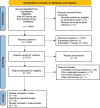Irrigation techniques used in spine surgery for surgical site infection prophylaxis: a systematic review and meta-analysis
- PMID: 36008858
- PMCID: PMC9414142
- DOI: 10.1186/s12891-022-05763-2
Irrigation techniques used in spine surgery for surgical site infection prophylaxis: a systematic review and meta-analysis
Abstract
Background: The greater likelihood of morbidity, mortality, length of hospital stays and poorer long-term outcomes as a result of surgical site infections secondary to spinal surgery makes prophylactic measures an imperative focus. Therefore, the aim of this review was to evaluate the available research related to the efficacy of different intraoperative irrigation techniques used in spinal surgery for surgical site infection (SSI) prophylaxis.
Methods: We performed a comprehensive search using Ovid Medline, EMBASE, Web of Science and the Cochrane library pertaining to this topic. Our meta-analysis was conducted according to PRISMA guidelines. The inclusion criteria consist of spine surgeries with intraoperative use of any wound irrigation technique, comparison groups with a different intraoperative irrigation technique or no irrigation, SSI identified with bacterial cultures or clinically in the postoperative period, reported SSI rates. Data extracted from eligible studies included, but was not limited to, SSI rates, irrigation technique and control technique. Exclusion criteria consist of articles with no human subjects, reviews, meta-analyses and case control studies and no details about SSI identification or rates. Pooled risk ratios were calculated. A meta-analysis was performed with a forest plot to determine risk estimates' heterogeneity with I2 index, Q-statistic, and p value under a random-effects model. Funnel plot was used to assess publication bias. All databases were last checked on January, 2022. PROBAST tool was used to assess both risk of bias and applicability concerns.
Results: After reviewing 1494 titles and abstracts, 18 articles met inclusion criteria. They included three prospective randomized-controlled trials, 13 retrospective cohort studies, two prospective cohort studies. There were 54 (1.8%) cases of SSIs in the povidone-iodine irrigation group (N = 2944) compared to 159 (4.6%) in the control group (N = 3408). Using intraoperative povidone-iodine wound irrigation produced an absolute risk reduction of 2.8%. Overall risk ratio was 0.32 (95% CI 0.20-0.53, p < 0.00001). In a global analysis, study heterogeneity and synthesizing mostly retrospective data were primary limitations.
Conclusion: The most evidence exists for povidone-iodine and has Level 2 evidence supporting SSI reduction during spinal surgery. Other antiseptic solutions such as dilute chlorhexidine lack published evidence in this patient population which limits the ability to draw conclusions related to its use in spinal surgery.
Level of evidence: II - Systematic Review with Meta-Analysis.
Keywords: Complications; Infection prophylaxis; Irrigation techniques; Spinal surgery; Surgical irrigation; Surgical site infection.
© 2022. The Author(s).
Conflict of interest statement
All authors have completed the ICMJE uniform disclosure form. BBC, JTB, DB presently receive consulting fees as a Globus Medical consultant. BBC receives honoraria for speaking, lectures presentation as a Globus Medical consultant. JTB presently receives consulting fees as a Acuity Surgical consultant. DB receives royalties from Blue Ocean Spine and Globus Medical. DB is member of International Spine Study Group and Scoliosis Research Society (no payments received).
The other authors have no conflicts of interest to declare.
Figures




Similar articles
-
Selection pressures of vancomycin powder use in spine surgery: a meta-analysis.Spine J. 2019 Jun;19(6):1076-1084. doi: 10.1016/j.spinee.2019.01.002. Epub 2019 Jan 17. Spine J. 2019. PMID: 30660741
-
The efficacy of intrawound vancomycin powder and povidone-iodine irrigation to prevent surgical site infections in complex instrumented spine surgery.Spine J. 2019 Oct;19(10):1648-1656. doi: 10.1016/j.spinee.2019.05.592. Epub 2019 May 31. Spine J. 2019. PMID: 31158503
-
Outcomes of an Intraoperative Povidone-Iodine Irrigation Protocol in Spinal Surgery for Surgical Site Infection Prevention.Clin Spine Surg. 2019 Dec;32(10):E449-E452. doi: 10.1097/BSD.0000000000000908. Clin Spine Surg. 2019. PMID: 31609802
-
Effectiveness of local vancomycin powder to decrease surgical site infections: a meta-analysis.Spine J. 2014 Mar 1;14(3):397-407. doi: 10.1016/j.spinee.2013.10.012. Epub 2013 Oct 30. Spine J. 2014. PMID: 24373682
-
Preoperative skin asepsis protocols using chlorhexidine versus povidone-iodine in veterinary surgery: A systematic review and meta-analysis.Vet Surg. 2022 Jul;51(5):744-752. doi: 10.1111/vsu.13810. Epub 2022 Apr 18. Vet Surg. 2022. PMID: 35437786 Free PMC article.
Cited by
-
Surgical and procedural antibiotic prophylaxis in the surgical ICU: an American Association for the Surgery of Trauma Critical Care Committee clinical consensus document.Trauma Surg Acute Care Open. 2024 Jun 3;9(1):e001305. doi: 10.1136/tsaco-2023-001305. eCollection 2024. Trauma Surg Acute Care Open. 2024. PMID: 38835633 Free PMC article.
-
The Efficacy of Prophylactic Vancomycin in Decreasing Surgical Site Infections in Adolescent Idiopathic Scoliosis Patients: A Large Multicenter Cohort Study.Iowa Orthop J. 2024;44(2):93-99. Iowa Orthop J. 2024. PMID: 39811169 Free PMC article.
-
Effectiveness of Gentamicin Wound Irrigation in Preventing Surgical Site Infection During Lumbar Spine Surgery: A Retrospective Study at a Rural Teaching Hospital in India.Cureus. 2023 Sep 27;15(9):e46094. doi: 10.7759/cureus.46094. eCollection 2023 Sep. Cureus. 2023. PMID: 37900478 Free PMC article.
-
The University of Oklahoma Inpatient Spine Protocol: optimizing surgical outcomes through standardized perioperative care.Geroscience. 2025 Aug 13. doi: 10.1007/s11357-025-01826-z. Online ahead of print. Geroscience. 2025. PMID: 40804577 Review.
-
RCT-based meta-analysis of povidone-iodine irrigation in spinal surgery: clarifying efficacy and safety.Eur Spine J. 2025 Aug 8. doi: 10.1007/s00586-025-09243-8. Online ahead of print. Eur Spine J. 2025. PMID: 40779037 Review.
References
Publication types
MeSH terms
Substances
LinkOut - more resources
Full Text Sources
Medical
Research Materials
Miscellaneous

